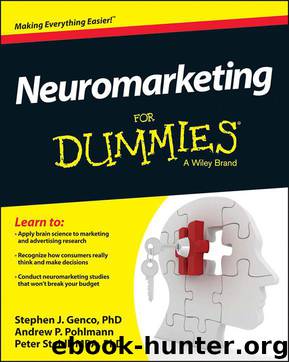Neuromarketing For Dummies (For Dummies (Business & Personal Finance)) by Stephen Genco & Andrew Pohlmann & Peter Steidl

Author:Stephen Genco & Andrew Pohlmann & Peter Steidl [Genco, Stephen]
Language: eng
Format: mobi
Publisher: Wiley
Published: 2013-07-17T14:00:00+00:00
Dissecting the feel-good ad
Some ads seem to violate all the rules of traditional advertising effectiveness. They don’t clamor for your attention. They contain no persuasive arguments. They barely mention the product at all, perhaps only with a low-key logo display at the end of the ad. They usually tell an emotionally engaging story, often set to catchy music, that has little to do with the product or brand, except for a subtle suggestion that the advertiser shares the positive values illustrated in the ad.
Yet, despite these violations, such ads can be highly effective. Although reliable data on financial performance of ad campaigns is hard to come by, one respected source is the Databank (http://staging.ipa.autometrics.com) from the Institute of Practitioners in Advertising (IPA), which contains over 1,400 case studies of successful advertising campaigns submitted to the IPA Effectiveness Awards competition over three decades. Researchers classified these campaigns as emotional, rational, or mixed in their basic appeal. They found that campaigns containing exclusively emotional content were twice as likely to produce very large profit gains than campaigns that emphasized rational content (31 percent versus 16 percent). Campaigns that mixed some emotional content with rational content also performed better than purely rational campaigns (26 percent versus 16 percent). According to these findings, emotional advertising works better than rational advertising where it matters: at the bottom line.
But how do these ads work? The answer begins with the way we process emotional input. As we explain in Chapter 5, emotional responses are primarily preconscious. We have circuitry in our brains that allows us to make a rapid emotional assessment of objects in our environment (creating emotional markers) well before we’re consciously aware of them. By the time we notice something, the object has already been “tagged” with an emotional marker that tells us whether it’s something we should approach or avoid. This process is highly efficient for our cognitive miser minds, because it occurs without the expenditure of costly cognitive resources required for conscious deliberation.
These emotional responses then get associated with the advertised brand through the psychological process of conditioning, in which responses to one object (the emotions generated by the ad) get transferred to another object (the brand). The mechanism by which conditioning occurs couldn’t be simpler; it’s repetition — the repeated presentation of the emotional response and the brand together.
Technically, this is the process of affective conditioning, which is different from classical conditioning, the process illustrated in the famous “Pavlov’s dogs” experiment. In affective conditioning, emotions associated with an ad aren’t just triggered by later exposure to the brand — they become an integral part of the brand identity.
Consider any of the strongest brand associations you can think of — achievement and Nike, creativity and Apple, safety and Michelin, family and Disney — all these associations have been built up by years and years of consistent conditioning through advertising (and other forms of marketing) that tied the two concepts together in your mind. And it all happened without any conscious effort on your part.
Download
This site does not store any files on its server. We only index and link to content provided by other sites. Please contact the content providers to delete copyright contents if any and email us, we'll remove relevant links or contents immediately.
Influence: The Psychology of Persuasion by Robert B. Cialdini(4695)
The Miracle Morning by Hal Elrod(4559)
The Hacking of the American Mind by Robert H. Lustig(4296)
Pre-Suasion: A Revolutionary Way to Influence and Persuade by Robert Cialdini(4117)
Unlabel: Selling You Without Selling Out by Marc Ecko(3573)
Ogilvy on Advertising by David Ogilvy(3481)
Hidden Persuasion: 33 psychological influence techniques in advertising by Marc Andrews & Matthijs van Leeuwen & Rick van Baaren(3448)
Purple Cow by Seth Godin(3122)
Who Can You Trust? by Rachel Botsman(3074)
Kick Ass in College: Highest Rated "How to Study in College" Book | 77 Ninja Study Skills Tips and Career Strategies | Motivational for College Students: A Guerrilla Guide to College Success by Fox Gunnar(3058)
This Is Marketing by Seth Godin(2958)
The Marketing Plan Handbook: Develop Big-Picture Marketing Plans for Pennies on the Dollar by Robert W. Bly(2945)
I Live in the Future & Here's How It Works by Nick Bilton(2919)
The Power of Broke by Daymond John(2872)
Building a StoryBrand by Donald Miller(2825)
The 46 Rules of Genius: An Innovator's Guide to Creativity (Voices That Matter) by Marty Neumeier(2774)
Draw to Win: A Crash Course on How to Lead, Sell, and Innovate With Your Visual Mind by Dan Roam(2716)
The Tipping Point by Malcolm Gladwell(2684)
Market Wizards by Jack D. Schwager(2627)
